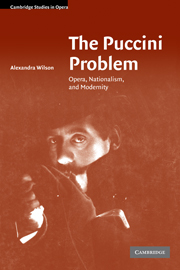Book contents
- Frontmatter
- Contents
- List of illustrations
- Acknowledgements
- Note on translations
- Introduction
- 1 Inventing an Italian composer
- 2 La bohème: organicism, progress and the press
- 3 Tosca: truth and lies
- 4 A frame without a canvas: Madama Butterfly and the superficial
- 5 Torrefranca versus Puccini
- 6 The Italian composer as internationalist
- 7 A suitable ending?
- Epilogue
- Appendix 1: selected newspapers and journals
- Appendix 2: personalia
- Notes
- Bibliography
- Index
4 - A frame without a canvas: Madama Butterfly and the superficial
Published online by Cambridge University Press: 22 September 2009
- Frontmatter
- Contents
- List of illustrations
- Acknowledgements
- Note on translations
- Introduction
- 1 Inventing an Italian composer
- 2 La bohème: organicism, progress and the press
- 3 Tosca: truth and lies
- 4 A frame without a canvas: Madama Butterfly and the superficial
- 5 Torrefranca versus Puccini
- 6 The Italian composer as internationalist
- 7 A suitable ending?
- Epilogue
- Appendix 1: selected newspapers and journals
- Appendix 2: personalia
- Notes
- Bibliography
- Index
Summary
‘Madama Butterfly flopped, flopped irredeemably. Last night's performance at La Scala was not just a failure; it was what one might frankly call a disaster, a catastrophe.’ Of all operatic fiascos, the first performance of Madama Butterfly at La Scala on 17 February 1904 ranks among the most notorious. The ominous silence that greeted much of Act I was replaced in Act II by contemptuous grunts, bellows, guffaws and even bird and animal noises. The rumpus was so loud that the voices and instruments were inaudible, to the point that the leading lady, Rosina Storchio, was reduced to tears when she could not hear her cues. The principal reason for this near-riot was the audience's impatience with a work that seemed excessively long by the customary standards of Italian opera, consisting of a first act of an hour and an interminable second act of ninety minutes.
However, the swiftness with which the disruption spread through the auditorium led to conspiracy theories, with Puccini's supporters immediately declaring foul play. The Ricordi journal Musica e musicisti discreetly relegated news of the disastrous première to a brief statement, claiming that the audience had been ill disposed to the opera from the moment the curtain rose, had gone on to create a pandemonium and had ‘left the theatre as pleased as Punch!’ The use of a hostile claque to disrupt an opera by a rival was not an uncommon practice at this time, although the Madama Butterfly première was an extreme case.
- Type
- Chapter
- Information
- The Puccini ProblemOpera, Nationalism, and Modernity, pp. 97 - 124Publisher: Cambridge University PressPrint publication year: 2007



